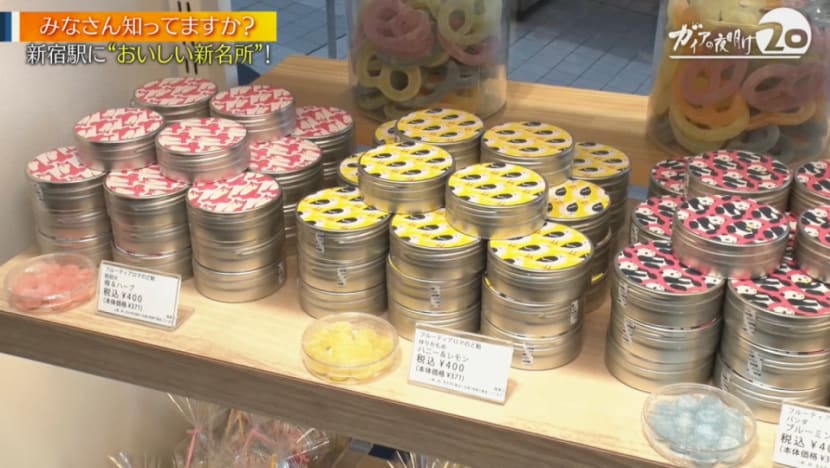Gaia Series 27: Responsible Consumption and Production
The sustainability efforts of two firms - candymaker Kanro with its edible straws and freight company Nishida Shoun which created biofuel from ramen lard and tempura oil - are highlighted this week.


This audio is generated by an AI tool.
This week, we feature companies’ sustainability efforts. Candy giant Kanro is one such firm. Founded in 1912, its headquarters are in Shinjuku, Tokyo. With approximately 600 staff, it has an annual turnover of about 25 billion yen. Despite facing a major problem of having to discard 1,200 tonnes of “substandard” candies annually, Kanro's commitment to sustainability has given rise to innovative projects that not only reduce waste but also contribute to a cleaner environment.
Kanro’s president is Kazuysasu Misu, who strongly believes in sustainable development goals (SDGs). For example, he came up with the idea of an edible candy straw to reduce plastic three years ago. In January 2023, the Department for Future Design Projects was launched, comprising cross-department experts in product development and planning. Their goal is to develop new products themed around the SDGs. They want to upcycle the company's products into goods for daily use. Product development expert Rie Kanazawa, who has worked for Kanro for about 25 years, is in charge of the Hitotsubu Kanro store in Shinjuku. She has developed several novel products and turned it into a popular store.
One of the products the team has created is wet wipes made from discarded candies. Kanro's Hikari Factory mainly makes hard candies and besides shavings - a byproduct of making candies - “rejected” chipped or misshapen candies are also discarded. Alcohol is made from the sugar in these discarded candies and soaked into unwoven fabrics to produce the wet wipes. Kanro's Toyasu Research Centre is located in Koto, Tokyo and this is where new flavours for candies and gummies are developed. One of its products that supports the SDGs is orange-flavoured gummies, made from the wrung-out remains of the orange. The company’s edible candy straw was also produced here.
Kanro’s Ms Kanazawa has also collaborated with a company in Oshu City, Iwate, called Fermenstation. The company ferments rice and creates ethanol, a type of alcohol, through distillation. It then uses this to develop cosmetics and other goods. Ms Kanazawa wants to use this same technology to use the Kando candy shavings to make other products too. So the shavings are added along with rice and yeast, after which the mixture is allowed to ferment to create fresh ethanol. So the anti-bacterial wipes were made using discarded Kanro candy and organic rice with alcohol.
Ms Kanazawa's sustainability journey did not end with candy waste. Sugar from sugar beet is used in many of the products made by Kanro. The same problem exists with sugar beet as with the candy shavings. The volume of sugar beet residue, called pomace, can be as high as 200,000 tonnes annually. So Ms Kanazawa worked with Nippon Beet Sugar Mfg. Co and Toyoshima - a textile company which uses materials such as plastic bottles and sugar cane to make sustainable clothes and accessories - to repurpose sugar beet pomace into sustainable fibres. From the fibre content in sugar beet, beet fibres in powder form are made. The innovative project aims to create eco-friendly fabrics such as towels from the fibres of sugar beet.
We move over to Shingu Town in Fukuoka, where a new initiative sees residents holding a monthly curbside recycling event involving waste oil from cookware. Fukuoka is famous for its tonkotsu ramen. However, thick oil is often seen in its leftover soup. One man is very interested in collecting the lard from restaurants. Masumi Nishida is the chairman of Nishida Shoun, a freight company with nearly 200 employees and about 130 trucks. He refines the lard from leftover tonkotsu ramen soup and waste tempura oil and then uses it as biodiesel fuel for his company’s trucks.
Mr Nishida started his freight company with only one truck at the age of 20. As the company expanded, he turned his attention to biofuel. Following many prototypes, he made his own biofuel and is still engaged in research to make improvements. The collected lard and discarded oil from restaurants are reborn into fuel at a biofuel factory production building next to the company headquarters. The lard from leftover tonkotsu soup and used tempura oil are blended together to produce biofuel. Forty-five per cent of Nishida Shoun’s trucks use the biofuel.
Besides producing biofuel, Mr Nishida has also invented a machine to remove the lard from leftover ramen soup. He has also received more requests from restaurants to have their waste oil collected and eventually turned into biofuel. One such company is pizza chain Pizza Cooc.
Another company which has collaborated with Nishida Shoun is Daiichi Koutsu Sangyo. With approximately 8,000 taxis under its belt, it has the largest taxi fleet in Japan. It wants to use the biofuel from Mr Nishida’s company in all its vehicles across Japan, including Okinawa.
Tips:
1) Cross-industry collaborations can lead to innovative ways to reduce waste and develop sustainable products
2) Waste can sometimes be transformed into a valuable resource, as proven by Nishida Shoun












